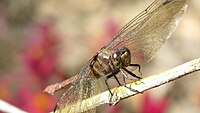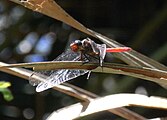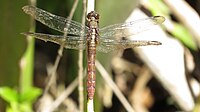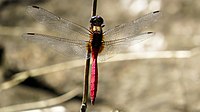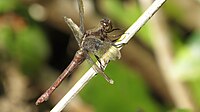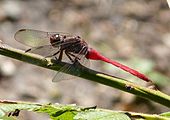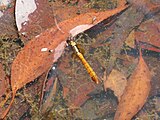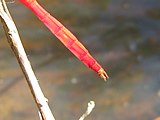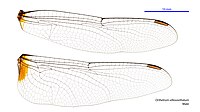
Orthetrum caledonicum, the blue skimmer, is a common Australian dragonfly in the family Libellulidae.

Brachydiplax denticauda is a species of dragonfly in the family Libellulidae known commonly as the palemouth. It is native to Australia, Indonesia, Papua New Guinea, and the Solomon Islands. It lives in habitat with still and slow-moving waters.
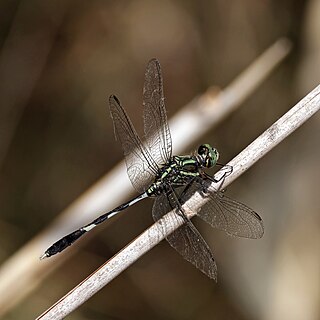
Orthetrum sabina, the slender skimmer or green marsh hawk, is a species of dragonfly in the family Libellulidae. It is widespread, being found from south-eastern Europe and North Africa to Japan and south to Australia and Micronesia.
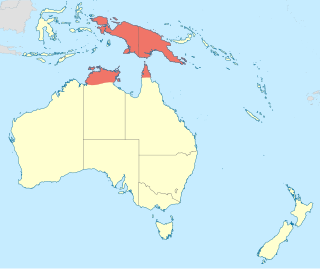
Orthetrum balteatum is a freshwater dragonfly species in the family Libellulidae, present in northern Australia and New Guinea. The common name for this species is speckled skimmer.

Orthetrum migratum is an Australian freshwater dragonfly species in the family Libellulidae. The common name for this species is rosy skimmer. It inhabits streams, boggy seepages, riverine pools and swamps across northern Australia.

Orthetrum serapia, the green skimmer, is a freshwater dragonfly in the family Libellulidae. The serapia species is present in Australia, the Philippines, Fiji, Papua New Guinea and Solomon Islands. It inhabits a wide range of still and sluggish waters, often shallow. In Australia it ranges from the top end of the Northern Territory to about Mackay in central Queensland.

Orthetrum boumiera is a freshwater dragonfly species in the family Libellulidae, endemic to eastern Australia, where it inhabits dune lakes. The common name for this species is brownwater skimmer.

Diplacodes nebulosa is a species of dragonfly in the family Libellulidae. It is a widely distributed species in many Asian countries. and northern Australia.

Nannodiplax rubra, commonly called the pygmy percher, is a species of dragonfly in the monotypic genus Nannodiplax. Its distribution seems to be limited to Australia and New Guinea. They are tiny dragonflies with a bright red abdomen and clear wings. They are found near a wide variety of rivers and streams. The Australian distribution ranges from Broome, Western Australia via the north and east to around Coffs Harbour, New South Wales. The taxon has not yet been assessed for the IUCN Red List, but it is listed in the Catalogue of Life.

Diplacodes melanopsis is a species of dragonfly in the family Libellulidae known commonly as the blackfaced percher or black-faced percher. It occurs on the Australian mainland from around Brisbane to the South Australian-Victorian border.

Hemicordulia continentalis is a species of dragonfly in the family Corduliidae, known as the fat-bellied emerald. It inhabits pools, lakes, ponds and swamps in coastal Queensland and northern New South Wales, Australia.
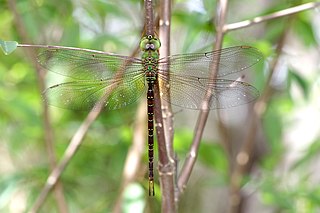
Gynacantha rosenbergi is a species of dragonfly in the family Aeshnidae, known as the grey duskhawker. It inhabits still waters and is found in New Guinea, Indonesia, through parts of northern Australia, as well as islands in the south Pacific.
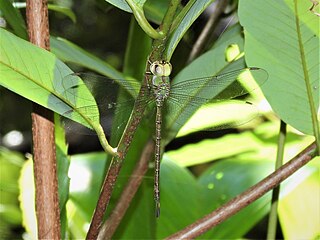
Gynacantha dobsoni is a species of dragonfly in the family Aeshnidae, known as the lesser duskhawker. It inhabits ponds and swamps and is found in northern Australia.

Gynacantha kirbyi is a species of dragonfly in the family Aeshnidae, known as the slender duskhawker. It is found in northern Queensland, Australia, the Maluku Islands, Tanimbar and New Guinea.

Gynacantha mocsaryi is a species of dragonfly in the family Aeshnidae, known as the paddle-tipped duskhawker. It is found in northern Queensland, Australia, the Maluku Islands and New Guinea.

Austrogomphus mjobergi, also known as Austrogomphus (Austrogomphus) mjobergi, is a species of dragonfly of the family Gomphidae, commonly known as the pimple-headed hunter. It inhabits rivers and pools across northern Australia.

Hemigomphus comitatus is a species of dragonfly of the family Gomphidae, known as the zebra vicetail. It is endemic to northern Queensland, Australia, where it inhabits streams and rivers.

Nannophya australis is a species of dragonfly of the family Libellulidae, known as the Australian pygmyfly. It inhabits boggy seepages and swamps in eastern Australia. It is a tiny dragonfly with black and red markings.

Neurothemis oligoneura is a species of dragonfly of the family Libellulidae, known as the spotted grasshawk. It is a medium-sized dragonfly with extensive darkening near the base of the wings found in northern Australia and New Guinea.
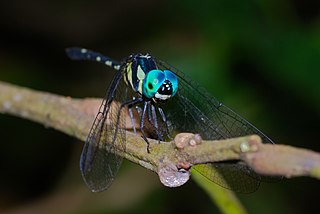
Tetrathemis irregularis is a species of dragonfly in the family Libellulidae, known as the rainforest elf. It is a tiny to small, slender dragonfly with black and yellow markings. It inhabits rainforest streams in north-eastern Australia and Southeast Asia, including the Aru Islands.




